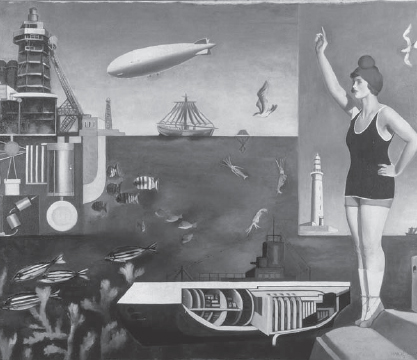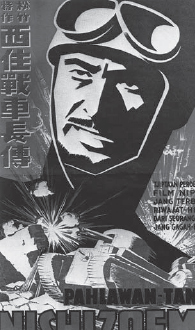Ways of Forgetting, Ways of Remembering (15 page)
Read Ways of Forgetting, Ways of Remembering Online
Authors: John W. Dower
Fig. 3-13. Yoshioka Kenji,
Official Commemoration Card: Attack on Pearl Harbor
. Government-issued postcard, 1943. Photograph © 2012 Museum of Fine Arts, Boston, from the Leonard A. Lauder Collection of Japanese Post Cards (2002.4256).
As consumerism and popular entertainment flourished, a spectacular world of advertising art developed with it that would, eventually, give much graphic wartime propaganda its distinctive look. Being up-to-date did not require choosing between Western fashions and more traditional clothing such as the kimono. On the contrary, commercial artists devoted themselves to capturing a chic aesthetic that embraced both styles and both traditions. Whereas the cosmetics firm Shiseid
Å
promoted an elegant image of feminine sophistication that highlighted the cosmopolitan, for example, department-store chains such as Mitsukoshi reached a huge audience of largely female consumers more comfortable with kimono and traditional hairstyles. The consumer could pick and choose, and the range of choices seemed to grow exponentially. Commercial artists touting almost everything under this new bourgeois sunâmovies, plays, musicals, books, magazines, beverages, cafes, clubs, restaurants, department stores, travel agenciesâsaw their handiwork reproduced not only in magazines and posters, but even on ubiquitous little boxes of matches. One could literally carry the new culture in one's pocket or pocketbook.
14
All this was complemented by creative innovation in photography and film-making, where the 1920s and 1930s witnessed path-breaking contributions that wedded foreign models and inspiration to indigenous visions and themes.
15
Avant-garde influences such as Surrealism permeated the arts (
Fig. 3-14
), and even where less radical modes of expression prevailed, fields such as painting still saw dramatic departures. Superlative work continued to be produced in the traditional Japanese style of representation
(
Nihonga
)âwith women in Western dress now joining the traditional kimono-clad beauty as a standard subjectâbut this was now complemented by a generation of artists trained in Western-style oil painting (
Y
Å
ga
).
16
Although little known to foreigners, even today, an enormous range of Japanese artists was thus immersed in visualizing and creating a new modernity as the militarists stepped in with their own version of what it meant to be modern. And in short order, however reluctantly, the artists fell in line. With few exceptions, they lent their talents to the war machine. They became part of the mobilization for total war. Even the charming comic-strip stray dog Norakuro became a military leader (
Fig. 3-15
).
Victors write the histories, the old cliché tells us; and where imperial Japan's war is concerned, that is more or less true. Postwar histories tend to focus on Japanese aggression and atrocity, as well they should. They dismiss the propaganda out of handâand this is more problematic. The propaganda was brilliant, and without confronting it squarely we are doomed never to grasp the full nature of Japan's warâand, by extension, never to have the broad comparative perspective necessary to see how all peoples and cultures make their wars beautiful, noble, and just.
In present-day Japan, it still remains largely taboo to exhibit the trappings of the great propaganda machinery of the war years. The reason why is obvious. Foreigners would denounce such displays as unrepentant neo-nationalism. Japanese critics on the political left would agree. And these critics would, indeed, be half correct. In Asia, now over a half century removed from the end of World War II, the wounds from imperial Japan's fifteen-year war remain open and painful on all sides, and their presence still defines contemporary struggles for national identity. The Chinese in particular beat the subject of Japan's war responsibility like a drum in pumping up their own present-day nationalism. And, on the opposite side, many conservative Japanese do still argue that the rhetoric of the war years was sincere and the war dead deserve to be mourned as
eirei
, departed heroes.
17

Fig. 3-14. Koga Harue,
Sea
. Japan, 1929. Oil on canvas; 51 ¼''x 63
â
''. Collection National Museum of Modern Art, Tokyo.
Koga's famous painting from the late 1920s captures the dramatic play of Western influences and indigenous engagement with the “modernity” that flourished in interwar Japan before the militarists gained control and tightened the screws of censorship and repression.
The need to mourn one's own dead is surely universal. In the case of Japan, however, it has not helped at all that since the mid-1960s many conservative prime ministers have chosen to do this by visiting Yasukuni Shrine, where the souls of those who once despoiled Asia were said to be reborn as cherry blossoms. They have usually scheduled these expressions of homage on or near the anniversary of the end of the war, without ever explaining to the outside world how such acts can be separated from homage to the
holy war itself. In such an obtuse political milieu, it is only natural that suspicion will fall on any serious attempt to reconstruct the atmosphere in which an entire nation was mobilized to fight and die.
Yet how else but by revisiting the past are we to understand how such tragedy comes about? The pernicious effect of sanitizing what can be publicly reexamined from Japan's fifteen-year conflict has been to withhold from the world one of the most adroit expressions of visual propaganda ever mobilized in the cause of a modern war. In the context of the times, it was certainly more elaborate than anything the beleaguered Chinese resistance that operated out of Chungking and Yenan for eight long years was able to mountâdivorced, as this resistance was, from the personnel, infrastructure, and plain physical security that made the Japanese propaganda effort so large and cohesive.
18
Beyond this, however, at almost every visual level of expressionâcartoons, posters, serious paintings, feature filmsâthe Japanese efforts also surpassed the overt propaganda of the Americans and British.
When the Hollywood director Frank Capra was recruited shortly after Pearl Harbor to prepare “documentary” propaganda films for the Army, he had the opportunity to screen many captured feature films that the Japanese had released in the course of the war in China. His response is often quoted in contemporary film circles. “We can't beat this kind of thing,” Capra exclaimed. “We make a film like that maybe once in a decade. We haven't got the actors.”
19
This was high praise indeed from a director renowned for his genius evoking the dignity of ordinary folk; and, in retrospect, Capra's observation remains not only persuasive but also applicable to other areas of wartime propaganda. Most Hollywood war films from the World War II period, for example, are of primary interest today for their formulas and stereotypes (the “multiethnic platoon,” the Japanese “beast in the jungle,” the hero who proves himself in battle). By contrast, many Japanese feature films are distinguished by levels of realism, and even restrained tones of humanism, that run counter to what most foreigners would expect
from the people who perpetrated the Rape of Nanking or eventually became famous for throwing away their lives in suicidal “
banzai
” charges. The films tend to focus on the sincerity, comradeship, and stolid self-sacrifice of their Japanese protagonists, rather than on battlefield mayhem and the killing game. They rarely zero
in at all on the enemyâwhether Chinese or Caucasian. More often than not, they keep speechifying to a minimum; long moments may pass without a word being spoken. Musical scores tend toward the melodic and romantic rather than the corny or stridently martial.
20

Fig. 3-15. Child's kimono, “Norakuro.” Japan, 1930s. Printed silk; 37 ½'' x 37 ¾''. Collection Tanaka Yoku, Tokyo. Courtesy of Bard Graduate Center: Decorative Arts, Design History, Material Culture; New York. Photographer: Nakagawa Tadaaki/Artec Studio.
Norakuro, the enormously popular stray dog hero of a cartoon strip by Tagawa Suih
Å
, made his debut in the monthly magazine
Sh
Å
nen Kurabu
(Boy's Club) in 1931 but quickly captured the fancy of girls and adults as well. As Japan became increasingly embroiled in war, Norakuro was drafted and given one military star; by the time this textile appeared, he had been promoted to three-star level.
In
Chocolate and Soldiers
, for exampleâproduced by the T
Å
h
Å
studio in 1938 as one of the first feature-length commercial war films ever made in Japanâthe protagonist is an utterly ordinary older draftee whom we never see in close combat. The film cuts back and forth between the China front and the Home Front, where the protagonist's wife and small son and daughter maintain a precarious existence in an extremely modest community. When news of his death is received (he was preparing for the advance on Nanking when last seen on screen) and the boy is told at the funeral service that his father was a hero, he responds “But who will take me fishing now?” The propaganda is subtle to a faultâa local storyteller glimpsed telling various war stories to youngsters, the orphaned son playing with a toy plane at the end, the blood debt one obviously owes to a simple, decent man who died for his country.

Fig. 3-16. Poster for the movie
The Story of Tank Commander Nishizumi
(Nishizumi seshach
Å
-den). Commissioned by Japan's Ministry of War, directed by Yoshimura Kenzabur
Å
, and released in 1940, this version of the film's well-known poster is directed to a Malay-speaking audience.
Japanese films were often translated for distribution in occupied areas. This advertisement for the feature film based on the life of a war hero killed in China in 1938 combines many characteristic features of wartime propagandaâthe sincere and resolute hero, the awesome machinery of war, and the slick style associated with commercial advertising and popular graphics, particularly after World War I.
In
The Story of Tank Commander Nishizumi
, a 1940 Sh
Å
chiku feature based on the actual story of a young officer who was enshrined as a military god (
gunshin
), viewers were introduced to the double theme of Japan's impressive war machinery (the tanks) and the suffering and heroic sacrifice of the nation's fighting men. Nishizumi does indeed face battle again and again, but we never see him kill anyone. His fatal wound comes when he is picked off by a dying Chinese soldier while testing the depth of a body of water his tanks must cross. Although he lingers before dying, there is no death scene and he is given no rousing final words. Nishizumi's godliness lies almost entirely in a purity that reveals itself in concern for his men (that is why he personally tests the water, rather than order his subordinates to do so), and in unquestioning acceptance of his duty to the nation (which is why he feels no need to pontificate about “why we fight,” a staple in most Hollywood scripts). Nishizumi and his tank would have made a splendid woodblock print of the sort that flourished during the Sino-Japanese and Russo-Japanese wars. Just as easily, they would have made a perfect subject for a boy's kimono (
Fig. 3-16
).